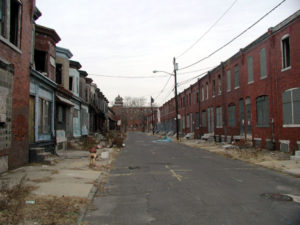In a previous post, we discussed how vacant lots and abandoned properties create complex challenges for many municipalities and noted that the lack of consistent definitions and reliable tracking systems is one hindrance to solving the problem. In this post, we delve into why it can be so difficult to redevelop and revitalize neighborhoods.
While vacant or underutilized properties are a problem all across the country in big cities, small towns, and rural areas, different factors may be contributing to the problem in different areas. Economic, demographic, and market changes are often a primary factor. In many areas, foreclosures from the previous decade’s mortgage crisis have been a major contributor. In older industrial areas, the shift away from manufacturing has left a legacy of abandoned commercial properties and high unemployment levels contributing to increased residential vacancies. In some areas, population decline seems to be an important contributor. For example, according to the U.S. Census Bureau, the population of the city of Philadelphia continually declined between 1950 and 2006. From 1950 to 1990, one North Philadelphia neighborhood lost almost half its population, dropping from 210,000 to 109,000 residents, while another lost two-thirds of its population, from 111,000 to 39,000 residents.[1]
One of the problems is that in most cities, no single entity is responsible for supervising, acquiring, assembling, and disposing of vacant parcels, or for considering the entire parcel inventory and making strategic decisions about how to manage it. Local governments have a wide array of building, housing, fire, and property maintenance codes that establish standards for the appearance and safety of properties, but it may not be clear who has primary responsibility for deciding what to do about a property that is not in compliance. A large number of agencies may be involved, and communication between agencies is often inefficient. For example, in 2000, responsibility for vacant properties in Philadelphia was divided among 15 public agencies.[1]
Code enforcement departments can typically issue fines for code violations or take action themselves, removing debris, mowing lawns, securing properties, making repairs, or even demolishing buildings if necessary, billing the responsible party for the costs. However, that method is only effective if the enforcement department can identify, locate, and obtain the cooperation of the responsible party. In some cases, ownership of a vacant property may be unclear, and even if the owner can be determined and contacted, they may not be willing or able to pay.
The City of Chicago ran into trouble with a large property owner in December 2011 after passing an ordinance requiring mortgage holders to register their buildings 30 days after they become vacant or 60 days after the mortgage goes into default, whichever is later. The City also required that mortgage holders of vacant buildings pay a $500 registration fee and secure and maintain the property. At the time, government-sponsored enterprises (GSEs) Fannie Mae and Freddie Mac owned about 258,000 mortgages in Chicago. As conservator for the GSEs, the Federal Housing Finance Agency (FHFA) sued the City, claiming that the GSEs should be exempt from the City’s ordinance. The U.S. District Court for the Northern District of Illinois agreed. After the judgement, the City and FHFA negotiated a settlement in which Fannie and Freddie will voluntarily register their vacant properties but will not be subject to the registration fee or any fines. The GSEs will not be subject to the City’s vacant building ordinances but will require that their mortgage servicers comply with guidelines for foreclosed properties.
Vacant properties are often purchased by investors, but investors may not invest in the properties or respond to code violations without appropriate financial incentives to do so. If investors are concerned that they won’t be able to recover their expenses, they may leave the property as is or transfer the title to another entity (a problem frequently noted in cities with large vacancy problems such as Detroit). That’s less of a problem in a strong market, but in weaker markets, government regulations and incentive programs then become critically important.
Aside from market dynamics, numerous factors affect the financial feasibility of property redevelopment, which may require considerable time, capital, and expertise depending on the condition and circumstances of the particular property. Dealing with foreclosure procedures, tax delinquencies, liens, and obtaining the necessary approvals and permits may be a time-consuming, inconsistent, and inefficient process. Different project stakeholders may have conflicting goals and visions. Local community members may not “buy-in” to proposed changes. Moreover, if the property in question might have contamination present, that exacerbates all of the previous issues and presents even more difficulties with additional concerns regarding past and future environmental liability.
According to the U.S. Environmental Protection Agency (EPA), a brownfield is “real property, the expansion, redevelopment, or reuse of which may be complicated by the presence or potential presence of a hazardous substance, pollutant, or contaminant.” Brownfields could be former service stations, dry cleaning facilities, factories, or warehouses. They might be residential properties that have served as meth labs or where asbestos waste was disposed in the soil; they might be sites where fracking activities once occurred. Many estimates put the number of brownfields in the United States at almost half a million sites.
Now that we’ve covered some of the challenges of neighborhood redevelopment, future posts in this series will focus on what’s being done to try to solve the problem and will highlight some of the success stories.
[1] Mark Alan Hughes. 2000. “Dirt Into Dollars: Converting Vacant Land Into Valuable Development.” Brookings Review 18(3). Accessed March 26, 2015 at https://www.brookings.edu/research/articles/2000/06/summer-metropolitanpolicy-hughes.







Recent Comments